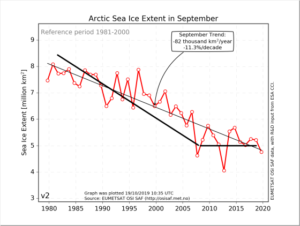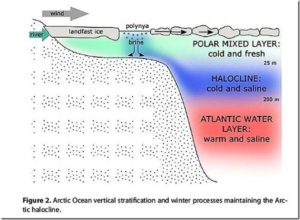by M. Wilelicki, Nov 7, 2023 in ClimateChangeDispatch
Dansgaard-Oeschger (D-O) events are one of the most striking discoveries in earth science related to past climate.
They are named after the two climatologists, Willi Dansgaard and Hans Oeschger, who were instrumental in their identification.
These events are rapid climate fluctuations that occurred frequently during the last glacial period, illustrating a planet capable of swift and dramatic temperature shifts. [emphasis, links added]
The discovery of D-O events can be traced back to the ice core drilling projects in Greenland in the late 20th century.
Analysis of the isotopic composition of ice cores, particularly the ratio of oxygen isotopes 18O and 16O, revealed evidence of abrupt climatic changes.
These isotopes served as proxies for past temperatures, with higher ratios indicating warmer periods.
The meticulous work of Dansgaard and Oeschger, along with their colleagues, in the 1980s led to the recognition that the Earth’s climate has not always changed at a steady pace but has seen dramatic swings, especially during the last glacial period around 115,000 to 11,700 years ago.
…
by University of Copenhagen, Dec 6, 2020 in WUWT
Researchers from the Niels Bohr Institute, University of Copenhagen have, in collaboration with Norwegian researchers in the ERC Synergy project, ICE2ICE, shown that abrupt climate change occurred as a result of widespread decrease of sea ice. This scientific breakthrough concludes a long-lasting debate on the mechanisms causing abrupt climate change during the glacial period. It also documents that the cause of the swiftness and extent of sudden climate change must be found in the oceans.
Scientific evidence for abrupt climate change in the past finally achieved
During the last glacial period, app. 10,000 – 110,000 years ago the northern hemisphere was covered in glacial ice and extensive sea ice, covering the Nordic seas. The cold glacial climate was interrupted by periods of fast warmup of up to 16.5 degrees Celsius over the Greenland ice sheet, the so called Dansgaard Oeschger events (D-O).
These rapid glacial climate fluctuations were discovered in the Greenland ice core drillings decades ago, but the cause of them have been hotly contested. D-O events are of particular significance today as the rate of warming seems to be very much like what can be observed in large parts of the Arctic nowadays. The new results show that the abrupt climate change in the past was closely linked to the quick and extensive decline in sea ice cover in the Nordic seas. Very important knowledge as sea ice is presently decreasing each year.
“Our, up until now, most extensive and detailed reconstruction of sea ice documents the importance of the rapid decrease of sea ice cover and the connected feedback mechanisms causing abrupt climate change”, says Henrik Sadatzki, first author of the study.
Sediment core and ice core data were combined in order to achieve the result
…
by P. Homewood, April 9, 2020 in NotaLotofpeopleKnowThat

http://ocean.dmi.dk/arctic/icecover_30y.uk.php
Most of us are probably familiar with the pattern of Arctic sea ice decline between 1979 and 2007, followed by a period of relative stability. Most of the decline took place after the mid 1990s.
The decline is nearly always explained away as the result of global warming, but a couple of old studies show this not to be the case.
In 2011, Robson & Sutton found that the sub polar gyre underwent remarkable and rapid warming in the mid 1990s, and that this was linked to changes in the North Atlantic Oscillation:
…
by Jim Steele, May 28, 2018 in WUWT
The globally averaged temperature rose 1.5°F from 1880 to today. Various narratives suggest the rise since 1950 was driven by increasing concentrations of CO2. The rising temperature before 1950 was considered natural. Since 1990, Arctic temperatures rose 2 to 3 times faster than the global average. So, are rapidly rising Arctic temperatures evidence of an impending climate crisis?
Astute students of climate history recall rapid Arctic warming has happened often and naturally. During the last Ice Age when CO2 concentrations were just half of today’s, 25 abrupt warming events happened. Arctic temperatures rose 9°F, and sometimes as much as 14°F in just 40 years. These rapid warming episodes are now called Dansgaard–Oeschger events (D-O events) in honor of the researchers who first detected them in Greenland’s ice cores. These D-O episodes affected global climate, changed ocean currents along California’s coast and altered the range of European forests.
What caused such abrupt warming? Basic physics dismisses changes in greenhouse gases or solar insolation because neither radiative effect induces such rapid warming. The most reasonable explanation suggests episodes of ventilating heat, that had accumulated in the Arctic Ocean, rapidly warmed the air.
…

La géologie, une science plus que passionnante … et diverse



